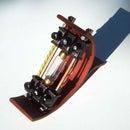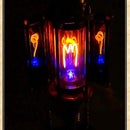Introduction: Steampunk Voltaic Arc Spectator (indispensable for Mad Scientists)
Dear friends, followers and DIY-enthusiasts!
As I announced at the end of my description of the "Steampunk Oriental Night Light - Nur-al-Andalus"- project, some days ago, here comes the second project (in a technical way the twin brother) using a CMH-Bulb in the center of this object called:
"Steampunk Voltaic Arc Spectator" which is definitely indispensable for Mad Scientists!!!
After writing so much about theory of CMB-Bulbs in my last instructable, I now just concentrate to the making of!
But before we can start I have to write this:
NOTE: All producers like GE, Philips and more others, write about a possible risk that a bulb could burst when it is running in its normal use. It is said that if this tube bursts, very hot (about 500°C) glass parts will be spread. So take care and do not wreck yourself. Better cover these bulbs with a protective glass shield.
My personal opinion and experience is that these bulbs are quite safe when they just glowing like I used to work with, especially when you use the very low power of these flash units. It seems to me, that it is nearly the same risk like working with neon gas filled bulbs or nixie tubes. These nearly dead CMH bulbs (and also brand new ones) just start to glow and they do not heat up. I measured at different times these bulbs while glowing under here described conditions! and they showed just the same temperature as the surrounding air in the room. Conclusion: This construction works deeply under the operating temperature! Literature talks about 6 exploded bulbs while highly running! in a number of 35 billions of produced bulbs! over a time of twenty years. But it is your own decision and I please you one more time not to harm you, and to take care of your health!!!
I hope that enjoy this constructive twin brother instructable to the Steampunk Oriental Night Light - Nur-al-Andalus project and I thank you for reading, watching, following and hopefully for voting at the trash to treasure contest 2019;-))
Yous Aeon Junophor
So let´s start!
Step 1: Short Description About This Spectator
In the center of this apparatus I placed a nearly dead CMH Bulb, hooded by a half cut copper tube which is constructed for being turned 360° around. From one side you can take a closer look through a magnifying object glass from a wrecked diascope and watch in detail the genius construction of this bulb type and on the other side there is a single glass lense which turns the picture upside down. Because of its only oft glowing of gases and metal vapors inside by using such a "nearly dead-bulb" (and of course only in this case!!!) -you can´t harm your eyes.
So you can discover the secrets of the ionized gases and take as a mad scientist a look into the depth of the universe muharr!!! muharr!!!
Step 2: Parts List
As you know, I love it to create new things in steampunk style, mostly/only out of scrap and that makes it difficult to give you a parts-list which enables you to copy this spectator one to one. But maybe it helps you a little bit to find your own creation so here it comes:
Parts list:
1 pc. of antique oval picture frame made of wood
I got the antique wodden picture frame (together with some other more) as a hand-me-down from my grandpa!
Brass and copper parts from plumber scrapyard:
1 pc. of copper fitting 18 x 22 mm, already used
2 pcs. of already used copper tubes 12 mm
one welded with and one pressed with fittings from central heating system
1 pc. of magnet valve brass made body, ¾ inch
1 pc. of coupling nut 1 inch, used
1 pc. of coupling nut 1/2 inch, from faucet
1 pc. of coupling ring 18 mm
1 pc. of O-ring, 40 mm, rubber
several parts to build the bulb hood top called „crown“
Parts from electric scrapyard:
1 pc. of object lense from wrecked diascope
1 pc. of single glass lense ø35 mm
1 pc. of flash unit from single use camera
2 pc. of 1.5 V AA-batteries from single use cameras
Different lengths of electric wires.
1 pc. of CMH-bulb, Philips TCM 35 Watts, nearly broken down
1 pc. of EDISON Screw socket E42 from 1.000 Watts incandescent bulb, made of brass
1 pc. of screw terminal
1 pc. of amber LED from a wrecked signal light
Parts from woodshop scrap:
2 pcs. of Plywood plate
Production wastage/rejects:
1pc. of brass tube 12 mm
1 pc. of copper tube 18 mm milled out
1 pc. of vulcanized fibre plate
Samples from trading companies:
4 ps. rubber feet 12 mm
Bought at Ebay or/and amazon:
1 pc. of micro switch
1pc. of micro push down button
1 pc. of Munsenring 42 mm, (brass)
1 pc. of Munsenring 35mm, (brass)
1pc. of batteryholder (4xAA-battery)
4 pcs. footplate for Munsen rings (brass)
Different pcs. of brass screws and washers
1pc. of aerosol can car finish, black
Step 3: Hooding the Bulb
A piece of milled out copper tube from production wastage, (outer diameter 18 mm, inner diameter 15.5 mm) fits perfectly around the CMH tube. I got a handful of this tubes from production wastage and if you cut them right in the middle, you get a pair of such "hood-bodies". One piece of an used copper tube (15 mm) already covered with a coupling ring is fixed with a combination of one M5 brass screw, two nuts, one washer and again one covernut by epoxy resin. At the end I attached a special ball bearing cage made of laminated fabric and the top crown is ready to be glued together again with epoxy resin. These cages also had been rejected from further production of bearings and had been thrown to the srap.
Step 4: Metal Works
The metal body from the magnet valve made of brass, was covered by a coupling nut fixed with epoxy resin. Than worked on the 18 x 22 mm copper fitting where I just took the former copper tube out.
I´ve just cut the rest of the former tube lengthwise with a sharp file, took a plier made one turning move and 30 seconds later I got this fitting ready for reusing here! This fitting was also attached to the valve top with epoxy resin. In this construction the prepared screw terminal fits perfectly in.
Next step was drilling a hole at the bottom of the valve to put the wires through later.
Then the two copper tubes with with screw fittings already on, got the prepared Munsen rings on, which later carries the single lense and the object lense, covered with the brass made Edison Screw socket E42!
Last step was to screw these new parts left and right to the open parts of the valve body.
Step 5: Woodworking
First a plate (3 mm) of red fibre was put into the old wood made picture frame from my grandpa. Then two plates of plywood had been screwed together with the frame. Next step was colouring the wooden parts with car finish(3 layers)
The I cut and drilled of the wooden parts to put in the switch and the push button in and also some spare place to keep the battery holder and some wires in. At the end, the former footplates of the munsen rings had been fixed with brass screws to the fibre plate.They now hold the former magnet valve body tight.
Step 6: Wiring at the End
The battery holder keeps the two needed AA-batteries (1,5 Volt each) which now supply the LED and the CMH-Bulb via flash unit as well as the flash board from the single use camera. Just some wires had to be soldered to the push button for the LED and to the switch to ignite the CMH bulb with the high voltage from the flash circuit.
The electronic and electric construction of this apparatus is nearly the same like the Steampunk Oriental Night Light - Nur-al-Andalus STEP 5, so I don´t want to bother you by repeating.
I hope you enjoyed this instructable
and if you like it please do not forget to vote for it at the trash to treasure contest 2019 !
Yours Aeon Junophor




